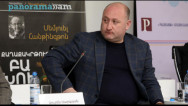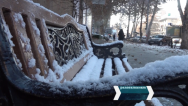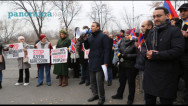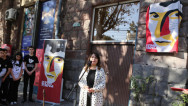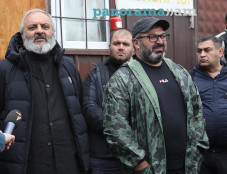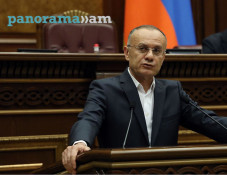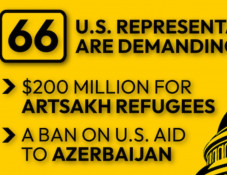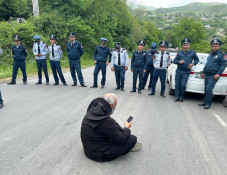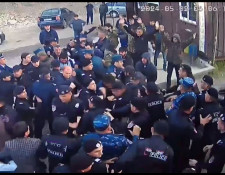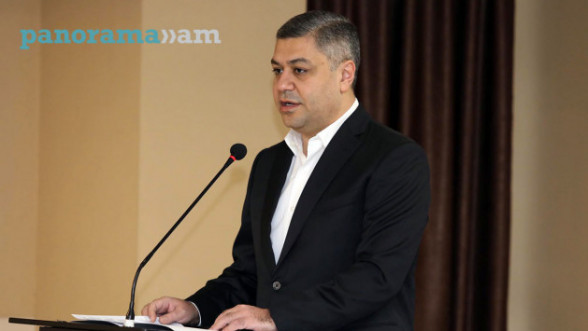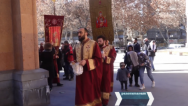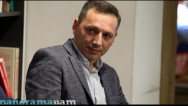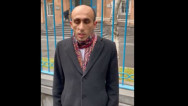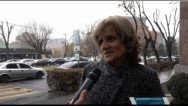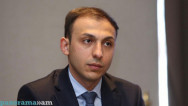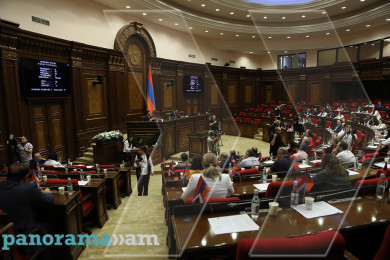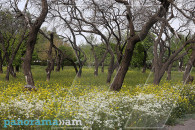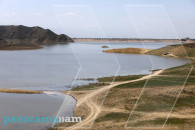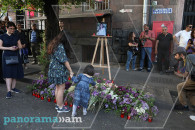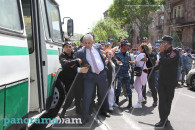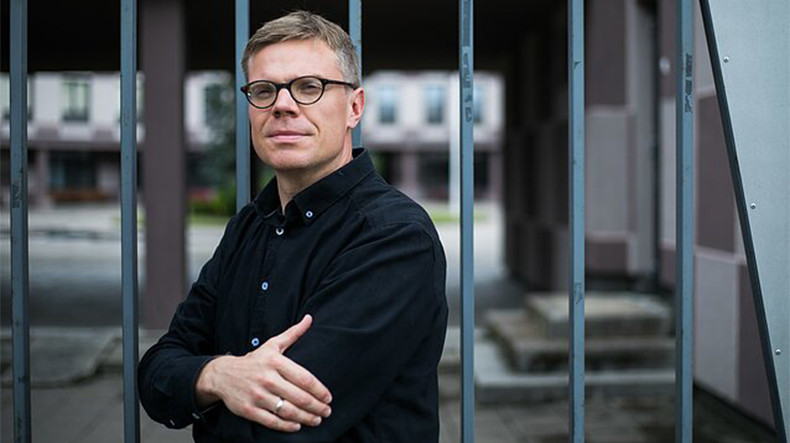
Zigmas Vitkus. “The Armenian Genocide - not forgotten”
Lithuanian National Radio and Television has published on its website an extensive article by Zigmas Vitkus, covering the Armenian Genocide and the history of construction of Tsiternakaberd Memorial Complex.
Panorama.am presents the article in its entirety in English below:
“In the 1930s, the Armenian Genocide, organized by the political elite of the Ottoman Empire in 1915-1917, had already been forgotten by Europeans. Apparently, it was not in vain, that Nazi führer Adolf Hitler, on the eve of the invasion of Poland to justify the violence against the locals, cynically and rhetorically asked his generals: “Who now remembers the Armenians?”
Today, however, 105 years later, the memory of those events is still alive, and the fact of the Genocide is recognized by respectable states, including Lithuania. During the Soviet era, this painful story was sought to be pushed out of public memory. In the spring of 1965, it returned with incredible force...
Search for a Scapegoat
In the late 19th century, Armenians were the largest non-Muslim community in Turkish Anatolia (also known as Asia Minor). In many respects, their position in the Ottoman Empire was reminiscent of the situation of the Jews in Europe.
Not having their own state (Armenians lost their statehood in 1375 when they were conquered by the Egyptian sultanate), marginalized economically and politically, isolated in a religious sense, the nation was still able to find niches that ensured high social status: crafts, trade, industry and agriculture. The Armenians stood out from the rest of the empire residents with an education that provided them with considerable opportunities in the liberal professions and local politics.
Historians agree that the massacre of Armenians organized by the Ottoman Empire's political elite was carried out due to a number of key factors: the fundamental vulnerability of Armenians within the country, which allowed them to be turned into scapegoats in the event of any state crisis of military failure; World War I, largely unsuccessful to Turkey and the decline of the empire throughout the 19th century, which provoked radical and paranoid governmental reactions to the activities of the Armenian community (they were accused of infidelity). Already in 1894–1896, between 80,000 and 300,000 Turkish Armenians were killed during world-shocking pogroms. It was a prelude to even greater massacres.
The Genocide, which, considering its scale, organization, and consequences, some historians call the first modern Genocide of the 20th century, began in 1915, April 24. That day, several hundred prominent and influential Armenians were arrested in the major cities of the Ottoman Empire.
Soon, most of them were killed. Armenian men, who served in the Turkish army, were demobilized and began to be systematically killed even earlier. The deportation of the rest to concentration camps in the Syrian desert began in May. Along the way, they had been awaited by armed criminals, deliberately released from prisons by the government, as well as by incited Kurdish and Turkish peasants through whose lands the road was stretched. Those, who were not killed, died of starvation and disease.
It is estimated that between 1915–1917 there were killed from 600 thousand up to 1.5 million Armenians. Whatever the exact number, at the end of the First World War, 90 percent of Armenians who had lived in Turkey until then, disappeared. Moreover, in the late 1920s, Turkey invaded the newly established independent Republic of Armenia and occupied most of its territory. The massacre continued during this invasion.
Completely weakened after the war, Armenia could no longer withstand Bolshevik Russia, whose army entered Yerevan and occupied a part of Armenia, which was not yet occupied by the Turks. In October 1921, part of the Armenian lands, including the territory with the central symbol of the nation's identity, Mount Ararat, were finally assigned to Turkey by the Treaty of Kars signed between the Bolsheviks in Russia, Armenia, Georgia, Azerbaijan and Turkey.
The silent topic of the Soviet era
The question of the Armenian Genocide in Soviet Russia (since 1922 - in the Soviet Union) remained untouched in public and existed only in the memory of families. According to German historian Susanne Buckley-Zistel, the Stalinist regime had already implemented, in her words, a strategy of "deliberately chosen amnesia" that avoided complicated discourses that could strengthen Armenian national feelings and "stay on the path of socialism", ostensibly, without looking at the past. In addition, it evaded the antagonism between Turkey and Armenia, which was to the detriment of the regime. Turkey and the Soviet Union under Stalin (and later) tried to coexist "amicably" and had even signed a nonaggression pact.
Armenians that were returned from Syria, Lebanon, Egypt, the Balkans, and other countries to Soviet Armenia in the 1950s (Stalinist regime organized a special action for it in 1945-1949) did not gain a voice, although the regime made some concessions for them. Suppose, the new settlements were allowed to be given the old Anatolian place names, including those areas where the Genocide took place. Of course, it did little to change, as the articulation of the Armenian Genocide in public sphere (if such existed in the Soviet state at all) continued to be repressed. Up until 1965, when forced silence accumulated and turned into unprecedented demonstrations.
Spring of 1965 in Yerevan
In 1965, the huge Armenian diaspora prepared to commemorate the 50th anniversary of the Genocide. As this date approached, the construction of monuments in memory of the victims of the Genocide began in various countries, lived by Armenians. The traditional Armenian stone sculpture was also erected in 1965 in Armenia, on a plot belonging to the Armenian Catholicos in Echmiadzin, near St. Cathedral of Our Lady (by the way, it is the oldest cathedral in the country, built on the foundations of a 4th century church). It was dedicated to the "victims of the 1915 Genocide" listing the ten largest sites of mass murder on the monument. However, it was a small and informal memorial in a "private" area.
Armenian SSR authorities were not going to silence the anniversary (there were too many witnesses of the Genocide in the country) and even prepared some "measures", but decided to hold the main event behind closed doors and broadcast live to the crowd through the speakers everything, that was happening inside (the event was scheduled at the Yerevan Opera House). The acceleration of Nikita Khrushchev’s warming period, which allowed people to breathe at least a little bit more freely, was still being felt, and tens of thousands of Armenians in 1965, April 24 even before the official event, gathered for an informal demonstration on Lenin Square in Yerevan. It was probably the first national rally of this scale, not only in Armenia, but also in the entire Soviet Union.
At the statue of Lenin, the crowd was shouting "[our] lands! [our] lands!”, demanding the release of students arrested by the government a year ago for forming an informal group to fight for the preservation of the Armenian language. The crowd then spilled across the city, urging people to join, and gathered again in the Opera Square in the evening. The above-mentioned official commemoration event, which was attended by the political and intellectual elite of the Armenian SSR, took place in the building of the Opera House. Demonstrators tried to get inside and hand the petition to the authorities. One would say that they tried to break in physically, but at the same time symbolically as well. Their aim was to show that the memory of Genocide is not just a privilege of the government.
The demonstration featured Armenian national songs and anti-Turkish slogans, photographs of victims, posters with the number 50, and images of Ararat. In addition, people demanded recognition of the Genocide and the erection of a national monument to commemorate the event. Also, to return Armenian lands from Turkey (handed over by the Soviets, as I mentioned, in 1921) and from neighboring Azerbaijan SSR. Thus, not only the foreign but also the domestic policy of the Soviet Union was questioned, and at the same time, the power of national self-consciousness was demonstrated. Understandably, the militia did not let people in. Then stones flew into the building. It was answered with a stream of water. The crowd, however, stormed in, and those, who were in the hall, withdrew through the emergency exit.
Why did the government not use more force back then? This can be judged by the material of the meeting of the Central Committee of the Armenian SSR Communist Party held after the demonstrations. The reaction was mitigated by the fact that the demonstrators did not question the Soviet system itself, and the government (with the chairman of the Communist Party Central Committee, Jakov Zarobian) thought similarly as the "ordinary people.”
At the meeting, he called for the Armenian national sentiments to be taken into account, actualized the rally in a "proper" ideological context according to Soviet rhetoric, spoke of the Genocide as a Turkish crime behind which German capitalists were standing, and so on. During the meeting, of course, obeisance was paid to the Soviet Union, as, allegedly, it was only thanks to it that such a commemoration could have taken place in general, however, the demonstration was not condemned in principle - only "hooliganism" and "nationalist and demagogic elements”.
The first monument to the victims of the Genocide in the Soviet Union?
One of the demands of the 1965 demonstrators was a call to the authorities to build a memorial to the victims of the Armenian Genocide. In fact, this project had already started before the demonstrations. In addition to national sentiments (of which there were many), the supreme government of the Armenian SSR realized that the national monument was a good way for the state to control the public genocide commemoration process and in March granted permission to build an obelisk and announced a nationwide competition in the local press. However, the demonstrators did not care much about it ... This time, Moscow (having maintained friendly relations with Turkey) was reassured that the monument will be dedicated to the Armenian martyrs of the First World War.
In the Soviet country, due to lack of funds, the implementation of any major architectural projects usually took longer, but in this case, the process of design and construction work proceeded surprisingly quickly and smoothly: the competition was announced in 1965 and the monument was completed at the end of 1967. This pace shows that it was also a priority project for the government. The memorial was built on Tsitsernakaberd (Swallow's Castle) hill, rising above Yerevan. This mountain offers a view of Mount Ararat, the symbolic significance of which for Armenian culture and identity is difficult to overestimate - it is the Armenian Jerusalem, the Heavenly Jerusalem of all Christians in the world, which is longed for but at the same time remains inaccessible.
The authors of the monument, architects Arthur Tarkanian, Sashur Kalashian, and sculptor Hovhannes Khachaturian, designed a two-part monument: a round Shrine of Remembrance and a 44-meter-high Obelisk of the Revival, symbolizing the rebirth of the Armenian people. The obelisk consists of two compressed parts as if growing from each other: the smaller one represents the diaspora, the larger one - Armenia.
The round memorial hall is designed from twelve sloping basalt steles (symbolizing 12 lost Armenian provinces and the figures of mourners) arranged in a circle around the eternal fire. The hall is sunk to a depth of 1.5 meters, which is reminiscent of about 1.5 million Armenians killed during the genocide. Between 1988-1990, the traditional Armenian crosses (khachkars) were erected in the neighborhood of the memorial, commemorating Armenians who died and were killed during the conflict with Azerbaijan.
Unveiled on November 29, 1967, on the occasion of the 47th anniversary of the Armenian SSR, the memorial had no inscriptions, although everyone knew what this memorial space was for. In Soviet times, the Day of Remembrance for the Victims of Genocide was never legalized in Armenia, but it actually existed. Like the monument to the victims of the Genocide. The Armenian SSR authorities also took part in the semi-official commemoration, officially honoring the "Armenians killed in World War I" in the official version, while thanking the Soviet Union for peace and security and condemning the imperialist ambitions.
At the same time, along with the memorial to the victims of the Genocide, a monumental sculpture by Ara Arutiunian “Mother Armenia” was unveiled in Yerevan Victory Park, an official symbol intended to unite Armenian people and express its self-image (the sculpture was erected on the same pedestal from which the figure of Stalin was removed five years ago then).
If the monument to the victims of the Genocide showed hope, then "Mother Armenia" (like "Mother of the Cross") was more in line with the Soviet narrative and spoke of the victory that was (and still is) being commemorated on May 9. To this day, these memorials are axial symbols of Armenian memorial culture along with the other one- bestowed by nature - the Ararat Volcano.
Newsfeed
Videos
